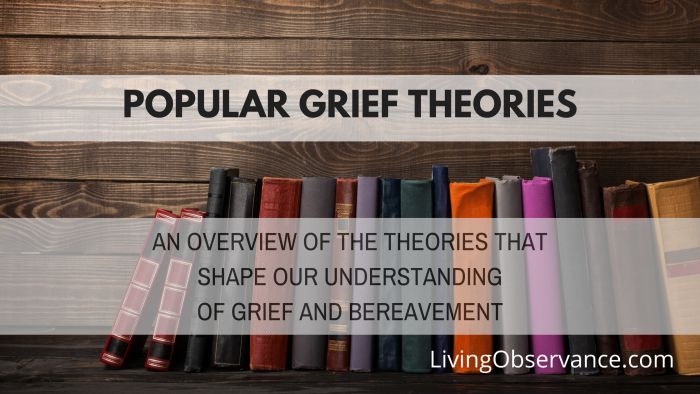Grief Theories
5 Stages of Grief 1969 by Dr. Kübler-Ross
- Dr. Kübler-Ross wrote a book summarizing her experience and conversations with over 200 patients that were facing the end of their own lives. This is widely regarded as the theory that brought grief theory to the mainstream.
- There is quite a bit of controversy surrounding this grief theory. If you are interested in more detail I’ve written an overview of the 5 Stages of Grief and the Top Criticisms of the 5 Stages of Grief.
- The theory suggests that there are 5 stages that a person will experience when they are facing the end of their own life. Those stages are:
- Denial
- Anger
- Bargaining
- Depression
- Acceptance
Psychosocial Transition 1971 by Dr. Colin Murray Parkes
- Dr. Parkes says in his 1971 paper introducing Psycho-Social Transitions that “Grief is seen as a process of “realization” by means of which affectional bonds are severed and old models of the world and the self are given up”
- Affectional bonds are the ties we make to aspects of our lives that we believe make up our identity. Anything that can be described as “mine” (my car, my school, my family, my city, etc) carries an affectional bond.
Two-Track 1981 by Professor Simon Shimshon Rubin
- Track I - How someone is functioning after a loss
- Track II - Relationship (memories, feelings, attachments and bonds to the person who died)
Four Tasks of Grief 1982 by J. William Worden, PhD
- Grief Counseling and Grief Therapy: A Handbook for the Mental Health Practitioner.
- 1. Accept the Reality of the Loss
- 2. Experience the Pain of Grief
- 3. Adjust to an Environment With the "Deceased" Missing
- 4. Find an Enduring Connection with the "Deceased" While Embarking on a New Life
New Model of Grief 1996 Dr. Tony Walter PhD
- The main model of grief can be summarized by Dr. Walter’s quote in his paper A New Model of Grief: Bereavement and Biography, “Trying to grasp the reality of the deceased being gone but yet being here, and doing this through continuously monitoring that reality by talking to those who knew them.”
- The model has 5 prominent elements
- 1. Many bereaved people want to talk to others who knew the deceased
- 2. Talking to a counselor or self-help group is second best
- 3. The purpose of grief is not to move on without the deceased, but to find a secure place for them. For the place to be secure, the image of the deceased has to be reasonably accurate as tested by others who knew the deceased.
- 4. It is difficult to connect with others who knew the deceased because of a more mobile, secular, and bureaucratic society.
- 5. Bereavement is part of the process of (auto)biography, and the biographical imperative - the need to make sense of self and others in a continuing narrative - is the motor that drives bereavement behavior.
Dual Process 1999 Dr. Henk Schut, PhD & Dr. Margaret Stroebe PhD
- Originally developed to better understand the loss of a partner
- There are two categories of events that cause stress for the bereaved
- Loss Oriented - “The Concentration on, and dealing with, processing of some aspect of the loss experience itself, most particularly, with respect to the deceased person
- Focusing on the bond with the deceased person and the circumstances surrounding the death
- Yearning for the deceased
- Looking at old photos
- Imagining how the deceased would react in various situations
- Crying about the death of the loved one
- Restoration Oriented - Secondary sources of stress “When a loved one dies, not only is their grief for the deceased person, one also has to adjust to substantial changes that are secondary consequences of loss. In many bereavements, these additional sources of stress add considerably to the burden of loss and cause extreme additional anxiety and upset.”
- Household Finances
- Cooking
- Reorganization of life without the loved one (ie: selling a home)
- Identity Changes (spouse to widow(er) )
- Driving
- Oscillation -
- Alternating between the Loss Oriented stressors and the Restoration Oriented stressors
- Confrontation and Avoidance of Grief - “At times the bereaved will be confronted by their loss, at other times they will avoid memories, be distracted, or seek relief by concentration on other things.”
- Loss Oriented - “The Concentration on, and dealing with, processing of some aspect of the loss experience itself, most particularly, with respect to the deceased person
Below there are some theories that I know of but haven’t been able to read the actual academic papers covering them yet. I’ll link to some of my favorite blogs and resources that already cover the theories.
Narrative and Constructivist Approach 2001 (Meaning Making Approach Video Interview) Dr. Robert A. Neimeyer, PhD
Trajectories Approach 2004 Dr. George Bonanno, PhD
Conclusion:
Grief and bereavement are deeply personal and fluid experiences. There is not a single grief theory that will fit your experience perfectly. Instead of trying to find the theory that explains your experience, I think it is better to pick and choose the pieces that work for you from the buffet of theories that exist.
I’ve compiled a list of the best practices in grief that helped my wife and I through the loss of our loved ones. I’ll also be adding a series of articles from professionals, religious leaders, and normal people sharing their experiences with bereavement. I’m sure that if you encounter more information and stories you will find something that resonates with you. It’s true that our grief experiences are unique, but you are not alone in your journey.


